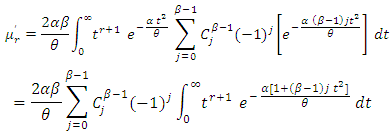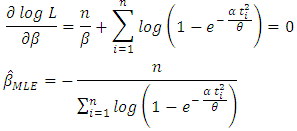| [1] | A. A. AL- Naqeeb, A. M. Hamed, (2009), “Estimation of the Two Parameters for Generalized Rayleigh Distribution Function Using Simulation Technique”, IBN AL- HAITHAM J. FO R PURE & APPL. SC I. VOL. 22 (4). |
| [2] | A. Ahmed, S.P. Ahmed and J.A. Joshi (2013). Bayesian analysis of Rayleigh distribution. Department of Statistics, University of Kashmir, Srinagar, India. |
| [3] | Abdullah Y. Al-Hossain, (2013), “Inferences on Compound Rayleigh Parameters with rogressively Type-II Censored Samples”, International Journal of Mathematical, Computational, Physical, Electrical and Computer Engineering Vol: 7, No: 4. |
| [4] | Alecxander M. Mood, Franklina Graybill, Duane C. Boes, (1974), “Introduction to the theory of statistics”, 3rd edition, International Student Edition. |
| [5] | Ali Abolhasani, Hossein Jabbari Khamnei, (2014), “Transformation method for Estimating P(X < Y) in the Case of Three Parameter Rayleigh Distribution”, International Journal of Nonlinear Science Vol. 17 (2014) No.1, pp.34-40. |
| [6] | Al – Naqeep A. A. and Hamed A.M. (2009), “Estimation of the two parameters for generalized Rayleigh distribution function using simulation technique” International journal of pure and applied sciences and technology, 22, 246 – 258. |
| [7] | Gauss, M. Cordeiro, Edwin M. M. Ortega and Daniel C.C. da Cunha, (2013), “The Exponential Generalized Class of Distributions”, Journal of Data Sciences, 11, 1 – 27. |
| [8] | Gupta R.D. and Kunda D. (1999), “Generalized exponential distributions”, Australian and New Zeland Journal of Statistics, 41, 173 – 188. |
| [9] | Gupta, R. D. and Kundu, D. (2001). Exponentiated exponential family: an alternative to gamma and Weibull distributions. Biometrical Journal, 43, 117-130. |
| [10] | M. Alizada, S.F. Bagheri and M. Khaleghy Moghaddam (2013), “Effect estimation of the density and cumulative distribution function of the generalized Rayleigh distribution”, J. Stat. Res. Iran, 10: 1- 22. |
| [11] | Mark A. Nielsen, (2011), “Parameter Estimation for the Two-Parameter Weibull Distribution”, BYU Scholars Archive. |
| [12] | Massimo Zanetti, Francesca Bovolo, (2015), “Rayleigh-Rice mixture parameter estimation via EMalgorithm for change detection in multispectralimages”, IEEE Transactions on Image Processing, Volume: 24, Issue: 12, Page(s): 5004 – 5016. |
| [13] | Merovci F. (2013), “transmuted Rayleigh distribution” Astralian journal of statistics, Vol.42, No.1, 21 – 31. |
| [14] | Mohammad Saleem and Mihamed Aslam, (2009), “On Bayesian Analysis of The Rayleigh Survival time Assuming the Random Censor Time”, Pak. J. Stat., Vol.25(2), 71 – 82. |
| [15] | Muhammad Shuaib Khan Robert King, (2015), “Transmuted Modified Inverse Rayleigh Distribution”, Austrian Journal of Statistics, Volume 44, 17–29. |
| [16] | Mood, Alexander M. Franklin A. Graybill, Duane C. Boes, (1974), “Introduction to the theory of statistics”, third ed. McGreaw – Hill book company. |
| [17] | Nadarajah S. and Kotez, (2006), “The exponentiated type distributions” Acta applicandae, Mathematics tp drought data. |
| [18] | Nekoukhou, V., Alamatsaz, M.H. and Bidram, H. (2013). Discrete generalizedexponential distribution of a second type. Statistics: A Journal of Theoretical and Applied Statistics, 47(4), 876-887. |
| [19] | SankuDey, (2008), “maximum Estimation of the parameter of the Rayleigh Distribution under Quadratic loss Function”, Data Science Journal, Vol.7, 23. |
| [20] | Tahani A. Abushal, (2011), “Estimation of the Unknown Parameters for the Compound Rayleigh Distribution Based on Progressive First-Failure-Censored Sampling”, Open Journal of Statistics, 1, 161-171. |
| [21] | Youngseuk Cho, Hokeun Sun and Kyeongjun Lee, (2014), “An Estimation of the Entropy for a Rayleigh Distribution Basedon Doubly-Generalized Type-II Hybrid Censored Samples”, Entropy, 16, 3655-3669. |


 by introducing two shapes parameters
by introducing two shapes parameters  since this distribution is important due to its many applications, in the analysis of signal and statistical error. Also it is a good model for representing remission time for (failure model) from certain disease that beat some people or anything else. The resulted distribution have three parameters,
since this distribution is important due to its many applications, in the analysis of signal and statistical error. Also it is a good model for representing remission time for (failure model) from certain disease that beat some people or anything else. The resulted distribution have three parameters,  is scale parameter,
is scale parameter,  are shaped parameters obtained from exposing one parameter Rayleigh into different exponents through
are shaped parameters obtained from exposing one parameter Rayleigh into different exponents through  this expansion done through introducing another parameters, this allow greater flexibility on the tail of distribution and permits wide application in the fields of engineering and biological studied.
this expansion done through introducing another parameters, this allow greater flexibility on the tail of distribution and permits wide application in the fields of engineering and biological studied.
 ). Many other researchers introduced transmuted Rayleigh like Merovci in (2013) [13] and (2014), also Khan M. Shuaib, King Robert introduced transmuted of Weibull, Merovci F. (2013) introduced transmuted Rayleigh and in (2014), Merovi F. introduced transmuted generalized Rayleigh. In (2016), Mohammed Shuaib [15] introduced three parameters transmuted Rayleigh.Many researchers proposed different formula to extend the base line distribution
). Many other researchers introduced transmuted Rayleigh like Merovci in (2013) [13] and (2014), also Khan M. Shuaib, King Robert introduced transmuted of Weibull, Merovci F. (2013) introduced transmuted Rayleigh and in (2014), Merovi F. introduced transmuted generalized Rayleigh. In (2016), Mohammed Shuaib [15] introduced three parameters transmuted Rayleigh.Many researchers proposed different formula to extend the base line distribution  to another form called exponentiated type distribution to obtain a new formula of p.d.f which may be gives greater flexibility and extend the scope of applications in engineering and biological applications. In our research we apply the formula given by Gauss, Ortega and Daniel (2013) [7] on one scale parameter Rayleigh to obtain new exponentiated three parameters Rayleigh. This paper deals with extending one parameter Rayleigh into three parameters one’s through applying definition shown in equation (3), the resulted p.d.f have one scale parameter
to another form called exponentiated type distribution to obtain a new formula of p.d.f which may be gives greater flexibility and extend the scope of applications in engineering and biological applications. In our research we apply the formula given by Gauss, Ortega and Daniel (2013) [7] on one scale parameter Rayleigh to obtain new exponentiated three parameters Rayleigh. This paper deals with extending one parameter Rayleigh into three parameters one’s through applying definition shown in equation (3), the resulted p.d.f have one scale parameter  and two shape parameters
and two shape parameters 





 then comparing different estimators of reliability function through simulation procedure by two methods (MLE, MOM), the comparison done using different sets of sample size and different sets of initial values of
then comparing different estimators of reliability function through simulation procedure by two methods (MLE, MOM), the comparison done using different sets of sample size and different sets of initial values of  the reseluts are compared using statistical measure mean square error (MSE).
the reseluts are compared using statistical measure mean square error (MSE). needs to solve implicit function obtained from applying moments or maximum likelihood methods, these methods of estimation need some algorithms for (MLE), also need equate sample moments
needs to solve implicit function obtained from applying moments or maximum likelihood methods, these methods of estimation need some algorithms for (MLE), also need equate sample moments  to obtain moment’s three estimators
to obtain moment’s three estimators  for more information and discussion see Al – Naqeeb and Hamed (2009) [6]. Now we explain the indicated methods for estimation.
for more information and discussion see Al – Naqeeb and Hamed (2009) [6]. Now we explain the indicated methods for estimation. 
 To simplify the formula for rth moments about origin we first apply the formula introduced by Mood, (1974) [3], which is;Since,
To simplify the formula for rth moments about origin we first apply the formula introduced by Mood, (1974) [3], which is;Since,


 for
for  we obtain
we obtain 
 be a random sample from
be a random sample from  in equation (4), then;
in equation (4), then;

 yields;
yields; 


 for the given values of
for the given values of  and estimated values of
and estimated values of 
 Then
Then Where
Where  is negative value and
is negative value and  reduced to positive.(α,Ө) are scale parameters and (β) is shape parameter for given values of (ti), and estimated values of (Ө,α,β), the following tables gives the results of simulation of:
reduced to positive.(α,Ө) are scale parameters and (β) is shape parameter for given values of (ti), and estimated values of (Ө,α,β), the following tables gives the results of simulation of: And also MSE of
And also MSE of 

 and two shapes parameters
and two shapes parameters  and then estimate reliability function, we find that
and then estimate reliability function, we find that  is best with percentage (54/96)×100%; while
is best with percentage (54/96)×100%; while  is best with (42/96)×100%; i.e
is best with (42/96)×100%; i.e  is best one due to best performance of maximum likelihood estimator as compared with another method of estimation, according to its properties which are invariant and have minimum variance and efficient and also consistent.
is best one due to best performance of maximum likelihood estimator as compared with another method of estimation, according to its properties which are invariant and have minimum variance and efficient and also consistent. Abstract
Abstract Reference
Reference Full-Text PDF
Full-Text PDF Full-text HTML
Full-text HTML